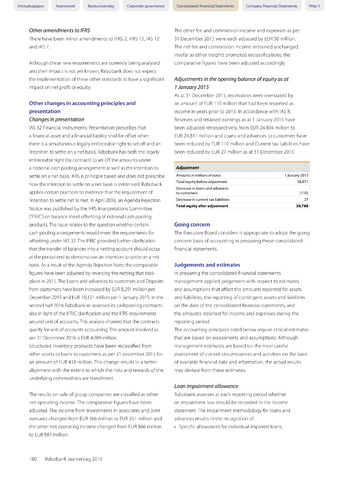Inhoudsopgave Voorwoord Bestuursverslag Corporate governance
Other amendments to IFRS
There have been minor amendments to IFRS 2, IFRS 15, IAS 12
and IAS 7.
Although these new requirements are currently being analysed
and their impact is not yet known, Rabobank does not expect
the implementation of these other standards to have a significant
impact on net profit or equity.
Other changes in accounting principles and
presentation
Changes in presentation
IAS 32 'Financial Instruments: Presentation'prescribes that
a financial asset and a financial liability shall be offset when
there is a simultaneous legally enforceable right to setoff and an
'intention to settle on a net basis', Rabobank has both the legally
enforceable right (by contract) to set off the amounts under
a notional cash pooling arrangement as well as the intention to
settle on a net basis. IFRS is principle based and does not prescribe
how the intention to settle on a net basis is evidenced. Rabobank
applies certain practices to evidence that the requirement of
'intention to settle net'is met. In April 2016, an Agenda Rejection
Notice was published by the IFRS Interpretations Committee
('IFRIC') on balance sheet offsetting of notional cash pooling
products.The issue relates to the question whether certain
cash pooling arrangements would meet the requirements for
offsetting under IAS 32.The IFRIC provided further clarification
that the transfer of balances into a netting account should occur
at the period end to demonstrate an intention to settle on a net
basis. As a result of the Agenda Rejection Note, the comparable
figures have been adjusted by reversing the netting that took
place in 2015.The Loans and advances to customers and Deposits
from customers have been increased by EUR 8,291 million per
December 2015 and EUR 10,121 million per 1 January 2015. In the
second half 2016 Rabobank re-assessed its cashpooling contracts
also in light of the IFRIC clarification and the IFRS requirements
around unit of accounts. This analysis showed that the contracts
qualify for unit of accounts accounting. The amount involved as
per 31 December 2016 is EUR 4,989 million.
Structured inventory products have been reclassified from
other assets to loans to customers as per 31 december 2015 for
an amount of EUR418 million.This change results in a better
alignment with the extent to which the risks and rewards of the
underlying commodities are transferred.
The results on sale of group companies are classified as other
net operating income.The comparative figures have been
adjusted.The income from investments in associates and joint
ventures changed from EUR 366 million to EUR 351 million and
the other net operating income changed from EUR 866 million
to EUR 881 million.
Consolidated Financial Statements Company Financial Statements Pillar 3
The other fee and commission income and expenses as per
31 December 2015 were each adjusted by EUR 50 million.
The net fee and commission income remained unchanged.
Insofar as other insights prompted reclassifications, the
comparative figures have been adjusted accordingly.
Adjustments in the opening balance of equity as at
7 January 2015
As at 31 December 2015, receivables were overstated by
an amount of EUR 110 million that had been reported as
income in years prior to 2013. In accordance with IAS 8,
Reserves and retained earnings as at 1 January 2015 have
been adjusted retrospectively, from EUR 24,894 million to
EUR 24,811 million and Loans and advances to customers have
been reduced by EUR 110 million and Current tax liabilities have
been reduced by EUR 27 million as at 31 December 2015.
Adjustment
Amounts in millions of euros
7 January 2015
Total equity before adjustment
38,871
Decrease in loans and advances
to customers
(110)
Decrease in current tax liabilities
27
Total equity after adjustment
38,788
Going concern
The Executive Board considers it appropriate to adopt the going
concern basis of accounting in preparing these consolidated
financial statements.
Judgements and estimates
In preparing the consolidated financial statements
management applied judgement with respect to estimates
and assumptions that affect the amounts reported for assets
and liabilities, the reporting of contingent assets and liabilities
on the date of the consolidated financial statements, and
the amounts reported for income and expenses during the
reporting period.
The accounting principles listed below require critical estimates
that are based on assessments and assumptions. Although
management estimates are based on the most careful
assessment of current circumstances and activities on the basis
of available financial data and information, the actual results
may deviate from these estimates.
Loan impairment allowance
Rabobank assesses at each reporting period whether
an impairment loss should be recorded in the income
statement. The impairment methodology for loans and
advances results in the recognition of:
Specific allowances for individual impaired loans;
180 Rabobank Jaarverslag 2016

